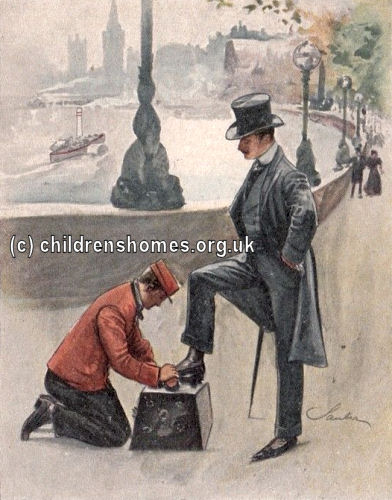East London Shoeblack Society and Industrial School, Whitechapel, London
The East London Shoeblack Society was established on July 31st, 1854, one of a dozen or so Shoeblack Brigades established in London in the mid-19th century to provide employment and accommodation for homeless and destitute boys. The Society was based at 4 Mansell Street, Whitechapel, (renumbered as 96 in about 1869) where accommodation was provided for up to 80 boys, mostly aged from 13 to 16. The East London Shoeblack Brigade included boys who were deaf and dumb, and physically disabled.

A London Shoeblack, c.1880s. © Peter Higginbotham
Shoeblacks were allocated pitches or 'stations' by the police and these were rotated twice a week so everyone had a turn at working at the most lucrative locations. Each Brigade had a distinctive uniform, with the East London boys adopting a blue guernsey. The boys' earnings were paid into the home each day with a third of the money paying for their keep, a third being placed into their individual bank savings accounts, and a third given back to them.
On July 1st, 1859, the establishment was formally certified as an Industrial School, allowing it to receive boys who had been placed under detention by magistrates. The boys received classroom lessons and also industrial training which included brush making, bag making, printing, blacking and ink manufacture.
The superintendent and matron of the Industrial School were Samuel and Mary Wise. The inspector's report for the School in November, 1868, recorded that "circumstances compelled the managers to require the resignation of Mr. Wise, who had been for many years the superintendent of the institution. He has been succeeded by Mr. Lark, who previously looked after the shoeblack brigade connected with the school. He is assisted by the clerk in the school office, and the officer who has succeeded him as outdoor inspector." The following year, Mr Lark (or Larke) resigned his post and was replaced by Mr Thomas Pitt, with Mrs Pitt as matron. The other staff now comprised two outdoor inspectors and a schoolmaster.
In September, 1870, an inspection report recorded 44 inmates in residence, of which 38 were committed cases and the remainder voluntary inmates. Besides these, there were 45 boys employed as shoeblacks, who were boarded but did not sleep in the institution, being lodged elsewhere and superintended by the officers of the school.
In 1872, larger premises for the Industrial School were secured at 43 Leman Street, Whitechapel (renumbered as 86 in about 1881). The School transferred to the new site early in 1873, with the Shoeblack Society initially remaining at Mansell Street. In 1885, however, after the School had moved to Lewisham, the Shoeblack Society moved to 86 Leman Street which had re-opened as the Whittington Club and Chambers for Working Youths.
The East London Shoeblack Society appears to have ceased operation in the early 1900s.
Records
Note: many repositories impose a closure period of up to 100 years for records identifying individuals. Before travelling a long distance, always check that the records you want to consult will be available.
- None identfied at present — any information welcome.
Bibliography
- Higginbotham, Peter Children's Homes: A History of Institutional Care for Britain's Young (2017, Pen & Sword)
- Mahood, Linda Policing Gender, Class and Family: Britain, 1850-1940 (1995, Univeristy of Alberta Press)
- Prahms, Wendy Newcastle Ragged and Industrial School (2006, The History Press)
Links
- None noted at present.
Except where indicated, this page () © Peter Higginbotham. Contents may not be reproduced without permission.


